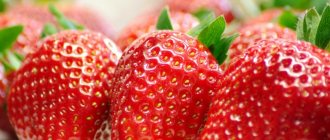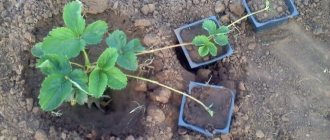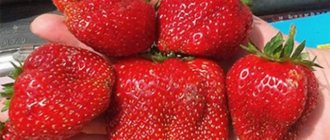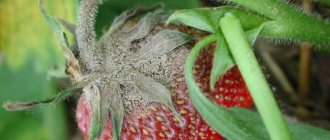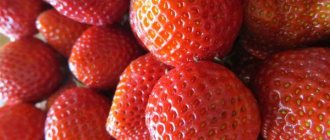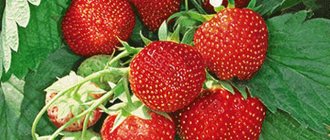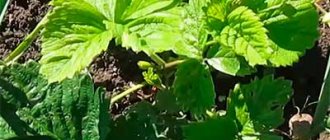Regular replanting of strawberries is an integral part of the agricultural technology of this world's favorite berry crop. Usually, in one place, a strawberry bush bears fruit for no more than four years, and then it grows old, begins to get sick often, and eventually stops producing fruit altogether.
However, breeders are not asleep and have already developed long-lived varieties capable of stably and abundantly bearing fruit for five or six, or even seven or eight seasons in a row without replanting the plantings! In addition, many of these varieties are also distinguished by increased bush vigor and fruit size, which also cannot but please gardeners.
We present to your attention the top 10 large-fruited strawberry varieties that can produce a harvest much longer than the common berry.
Large-fruited strawberry Gigantella Maxim
This is perhaps the most famous variety of such elite giant strawberries today, although it is not the most “durable” of those listed - on average, it grows well and bears fruit in one place for 4-6 years.
Dutch variety, mid-late.
Strawberry bushes are large, up to 50 cm in height and width. The variety is frost and drought resistant, the berry is not afraid of rainy weather. With well-established agricultural technology (intensive lighting, mandatory fertilizing and watering, regular treatment against diseases) it produces up to 2 kg of berries per bush.
The berries are flat-round, bright red, weighing up to 120 g (on average 50-60 g). The pulp is juicy and dense, the taste of the berry is rich, sweet, with notes of pineapple and strawberries. Strawberries of this variety retain their taste even after freezing, and are also easily transported.
Description of the variety and photo
This hybrid, despite the Russian name, was created by the Dutch. It is remontant, that is, it bears fruit continuously until autumn. At the same time, the berries ripen early. You can harvest your first harvest a couple of weeks earlier than other large-fruited garden strawberries. The variety is frost-resistant, as the creators claim, and can withstand temperatures down to -35 degrees.
Russian giant f1 is a hanging plant and can be grown in pots. It blooms constantly, producing large, white flowers with a pink tint. Numerous flower stalks of up to 30 pieces are particularly powerful. The bush is dense, grows up to 20 cm in height.
Experts cite the following advantages:
- Its versatility: strawberries are suitable for growing in pots at home (for example, on a balcony), in a greenhouse and for fruiting in open ground in summer cottages and garden plots.
- The berries are well stored, they are suitable for transportation, do not wrinkle, maintaining their presentation even after a long journey. It is worth remembering that it is important to follow the transportation rules; in closed vans with high temperatures and without air circulation, it is difficult to preserve the harvest.
- Pleasant taste and strong aroma distinguish this variety from other large-fruited varieties, which usually have a sour taste.
- High yield, continuous fruiting. From one bush per season it is possible to collect up to one and a half kilograms.
Large-fruited strawberry Lord
But this variety breaks all records for longevity - in one place, with proper care, it can actively bear fruit without chopping the berries for up to 10 years! Although experienced gardeners note that in the seventh year the berries begin to decrease in size, so it is more advisable to start replanting the bushes.
English variety, mid-late.
Strawberry bushes are large, up to 60 cm in height and width, and grow quickly. The variety is frost-resistant and extremely unpretentious in care, it is almost not damaged by strawberry mites and gray rot, but is not resistant to spotting. If agricultural practices are followed, it produces up to 2-3 kg of berries per bush.
The berries are cone-shaped with a blunt tip, deep red, shiny, weighing up to 110 g (on average 70-80 g). The pulp is dense, aromatic, the taste of the berry is sweet with a slight sourness. Strawberries of this variety are perfectly stored and transported.
Benefits of strawberries
Any strawberries, regardless of their size, are not only tasty and can be used as a treat, but also very healthy. Strawberries have excellent hematopoietic properties, help restore salt metabolism in the body, are used in the treatment of kidney diseases and atherosclerosis, and have a beneficial effect on the digestive system.
Strawberries contain a very large amount of vitamin C and are only inferior in its content to black currants. Eating five large strawberries can replace one orange! Strawberries are also very rich in folic acid, which is so necessary for pregnant women for the proper formation and development of the fetus.
Despite the fact that strawberries are sweet, they can be consumed even by people with diabetes, as they can lower blood sugar levels. In addition, strawberries are also useful for anemia, as they replenish iron deficiency.
Large-fruited strawberry Black Prince
Another long-lived variety, capable of actively bearing fruit in one place without chopping the berries for 7-9 years.
Variety of Italian selection, mid-early.
Strawberry bushes are wide and densely leafy. The variety has increased frost resistance, but in summer it requires increased watering. This strawberry is resistant to many common diseases, but is very susceptible to the transparent strawberry mite. With proper agricultural technology on light, breathable soils, it produces at least 1 kg of berries per bush.
The berries are truncated-conical in shape, thick dark red in color, weighing about 60 g. The pulp is juicy and very dense, the aroma is bright, the taste of the berry is rich, sweet and sour, with pronounced strawberry notes. Strawberries of this variety are easily transported, are well stored fresh, and are suitable for all types of canning.
Appearance
You can recognize the strawberry variety Giant Jorneya by its appearance just by seeing its bushes. They are very powerful, spreading and large. They give the impression of thoroughness! You immediately understand that the breeders named this variety not only for its large berries.
The berries can be called simply huge in comparison with other varieties: they can reach a weight of 60 grams! The color of the berries is very rich red, it seems that they are filled with juice. The shape is conically round.
The strawberry pulp of this variety is very juicy, with a bright strawberry aroma, which distinguishes the Giant Journey strawberry from other large-fruited varieties, which often have a mediocre taste. The berry is not overly hard, but dense and elastic, which allows strawberries of this variety to be transported over long distances without deteriorating in appearance.
Large-fruited strawberry Chamora Turusi
For strawberries of this variety, the highest yield occurs in the 3rd-4th years after planting, although it is possible to grow it without replanting for about 6-8 years. Moreover, with proper care, the berry practically does not become smaller over time.
The variety is presumably of Japanese selection, medium-late, early-bearing.
Strawberry bushes are large, spreading, grow quickly and strongly. The variety is winter-hardy, but does not like drought and direct sun, and requires abundant watering and regular fertilizing. It is extremely unstable to fungal diseases and the effects of insect pests (chafer and weevil larvae, slugs), although it has good resistance to powdery mildew and verticillium. If agricultural practices are followed, it produces up to 2-3 kg of berries per bush (on average about 1.2 kg).
The berries are round-comb-shaped with a blunt tip, intense red, weighing up to 120 g (on average 60-70 g). The pulp is dense, fleshy, with a strong aroma, the taste of the berry is sweet and sugary. Strawberries of this variety are well transported, suitable for fresh consumption and all methods of canning.
Reproduction
Like any garden strawberry, "Giant Journeya" propagates by tendrils or by dividing the bush. But the variety’s yield is low, which is why it is considered rare among gardeners.
Many summer residents sow the seeds of the “Giant Journeya”, thereby obtaining excellent planting material. Germination rate is almost 100 percent.
The basic rule when sowing is that the seeds must be fresh. With proper care of seedlings, you can get good, strong seedlings and harvest in the first year after planting.
Large-fruited strawberry Giant Journeya
This is one of the most productive and promising new strawberry varieties. It can grow in one place without replanting for up to 6 years, although it reaches its highest yield in the third year.
American variety, mid-early.
Strawberry bushes are powerful, tall, with large leaves. The variety is exceptionally frost- and drought-resistant and has excellent resistance to diseases and pests. It grows well on any type of soil, and if agricultural practices are followed, it consistently produces about 1.5 kg of berries per bush.
The berries are round-elongated, dark red, weighing up to 100 g (on average 40-50 g). The pulp is very dense, juicy, with a strong strawberry aroma, the taste of the berry is sweet, with notes of strawberry. Strawberries of this variety are easily transported.
Planting and propagation
Gigantella is obtained in 3 ways: from seeds, by rooting tendrils, and by dividing bushes.
Growing from seeds
- In order to grow this plant, you need to prepare the soil well - humus, sand, soil in a ratio of 5: 3: 3.
- Such a composition must be heated in advance in the oven at t = 1200, and then poured into containers (plastic cups, planting containers).
- This is followed by compaction and watering. The seeds are laid out in the holes made, and the containers (glasses) are placed in a cold place until germination. When the first shoots appear (after 20-25 days), the young seedlings need to be dived and moved to a warm place (above +230).
- Here they must be grown until stems and leaves form. Planting of garden strawberries “Gigantella” in the ground should be done when about six leaves appear on the bushes, usually this is done in May.
- When replanting, the optimal time for which is inclement weather.
- We recommend trimming the roots to a length of 6-7 centimeters.
Advice! Renew the planting material every 3-4 years, otherwise the berries will become smaller.
Landing with a mustache
The bush grows at a rapid pace, throwing out a huge number of mustaches. If your goal is a good harvest, then you need to remove them according to the degree of occurrence.
To obtain planting material, several bushes are enough.
Here, only five tendrils are dug in for rooting, so as not to weaken the mother bush.
Carpet method
Gigantella is also grown using the carpet method, rooting all the mustaches. New rosettes, according to the degree of foliage growth, begin to produce peduncles and bear fruit for more than one year.
Note! In subsequent seasons after planting, caring for Gigantella begins from the moment the snow melts. Before flowering, the plant is watered abundantly, but during flowering this procedure is not recommended. In order to retain moisture, it is advisable to mulch with sawdust, straw, pine needles, and leaves. Experienced gardeners recommend using Christmas tree or pine needles.
Large-fruited strawberry Kamrad Winner
This variety, in addition to its large, tasty berries, is loved by gardeners because it can bear fruit quite well in one place for 5-7 years. High-quality fruiting begins in the second year.
Variety of German selection, mid-late.
Strawberry bushes are powerful, up to 40 cm in height and width, with wide dark green leaves. The variety is drought and frost resistant and successfully resists most diseases. Productivity strongly depends on the climate, soil quality and thorough agricultural technology (watering, mandatory fertilizing, treatment with a fruit stimulant, mulching, shelter for the winter), on average it produces about 0.8 kg of berries per bush.
The berries are round-conical, dark red, glossy, weighing up to 100 g (on average 40-60 g). The pulp is dense, sugary, aromatic, the taste of the berry is delicate, sweet, dessert. Strawberries of this variety are suitable for fresh consumption and all types of canning.
Variety Gigantella Maxi
From the name of this variety, it becomes clear that the size of the berries of this strawberry is not inferior to the Giant Journey, and even surpasses it! It would seem much more, but, meanwhile, the weight of Gigantella strawberries ranges from 100 grams or even more.
The bushes of this variety are tall, strong, and well developed. The leaves are large and wide, very stable and tall peduncles with a thickened stem are able to withstand the weight of such truly gigantic fruits.
The berries are very large, shaped like cones with an obtuse angle. The pulp is bright, juicy, the berry itself is elastic and dense, very sweet, which again makes it possible to transport crops over long distances without losing their appearance and taste.
This variety is also distinguished by its high yield: ripe berries can be picked about three times during the spring-summer season.
One has only to draw the attention of those wishing to plant this variety to the fact that it produces the largest berries during the first harvest. In the future, the fruits may be a third less than the berries of the first harvest. But grinding does not affect their taste.
The Gigantella maxi variety takes root equally well and bears fruit when planted in the ground both in early spring and in autumn - in September-October.
Gardeners will also be pleased with the fact that Gigantella strawberries are very resistant to the development of diseases, especially fungal ones, and have excellent resistance to insect pests. You won’t have to suffer and torment them with various chemicals with these strawberries.
Large-fruited strawberry Kiss Nellis
This fairly new (2014) and very viable variety bears fruit perfectly in one place for up to 8 years (guaranteed - five to six).
The variety is presumably of Dutch selection, mid-early.
Strawberry bushes are powerful, up to 50 cm in height and width, with large corrugated leaves and strong peduncles. The variety is frost-hardy and resistant to most diseases and pests typical of this crop. If agricultural practices are followed (mandatory phosphorus-potassium fertilizing and pest control), it produces an average of 1.5 kg of berries per bush.
The berries are cone-shaped with a blunt truncated tip, cherry-colored, shiny, weighing up to 150 g (on average 60-80 g). The pulp is dense, aromatic, juicy, the taste of the berry is sweet and sour with a hint of strawberry. Strawberries of this variety are easily transported.
Large-fruited strawberry Primella
This fairly well-known variety with an extended ripening period feels great in one place for up to 7 years.
Dutch variety, mid-late.
Strawberry bushes are powerful, semi-spreading, with light green, large and wrinkled leaves. The variety is frost- and drought-resistant, extremely unpretentious in care. Almost not damaged by pests and diseases, with the exception of nematodes. If you follow minimal agricultural technology, it produces up to 2 kg of berries per bush.
The berries are round-conical, deep red, unevenly colored, weighing up to 100 g (on average 55-65 g). The pulp is dense, smells like wild strawberries with notes of pineapple, the taste of the berry is sweet, also with a distinct pineapple flavor. Strawberries of this variety are easily transported.
Care
The seedlings are unpretentious and adapt to any soil and climate. They like regular watering. With a lack of moisture, plant growth deteriorates and the quality of fruiting decreases. In addition, with an excess of liquid, a decrease in the protective properties of plants against various diseases is observed. Too much nutrition has a bad effect on yield.
The advantage of this strawberry is its resistance to pests and diseases. In addition, it is able to withstand dry and frosty periods, although not without loss in yield.
Large-fruited strawberries UK
This is still a little “promoted”, but very promising variety of strawberry, with timely phosphorus-potassium fertilizing, it grows and bears fruit in one place for up to 6 years.
The variety is presumably of English selection, medium-late.
Strawberry bushes are very powerful, although not too tall, with large, rich green leaves. The variety is frost-resistant and has excellent resistance to most diseases. If agricultural practices are followed, it produces about 2 kg of berries per bush.
The berries are round-conical, cherry-colored, shiny, weighing up to 120 g (on average 60-80 g). The pulp is dense, juicy, aromatic, the taste of the berry is sweet and sour with strawberry notes. Strawberries of this variety are easily transported and stored for a long time.
